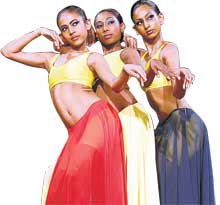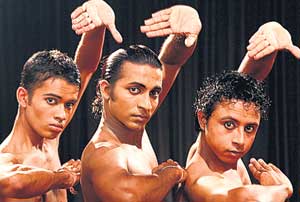Jealousy is not one, but a combination of emotions and human conditions, such as anger, loneliness, fear, betrayal, depression and cowardliness. Through dance, they talked about this.
Sounds familiar?
A few months ago, the dance troupe nATANDA explored this theme through body language, movement and expression in their performance Issuki. The production saw a fusion of dance styles from traditional Kandyan dance to the more contemporary dance styles such as jazz and modern ballet as well as Angampora, Sri Lankan martial art.
Well, for those who wanted to see it but missed it, or for those who've heard about it so much from others and wished they've seen it, not to worry. nATANDA will perform Issuki again this August and here's something to note…do not miss it this time.
Issuki is a Sanskrit term, meaning jealousy - the vicious, evil and destructive condition that affects not only an individual, but society as a whole. A countless number of artistes have explored this theme in their work, but still jealousy prevails and remains a vital issue that needs to be addressed.
"When you try to do something new, there is a lot of opposition. I think most of it is triggered by jealousy," says Kapila Palihawadana, founder and choreographer of nATANDA which promotes and pushes limits in terms of dance theatre in Sri Lanka. "Apart from this, the war itself is a result of this jealousy and all these other human conditions that lead to jealousy," Kapila adds.
Dance, says Kapila, is an effective form or medium through which such conditions can be portrayed and its gravity conveyed to the audience. Kapila seeks to 'talk' through dance with his most valued partner – the audience.
The performance is in two parts. The first consists of more contemporary dance styles such as jazz and modern ballet, Kapila explains. "This part is not very long and contains nice movements and free dancing," he adds.
The second part begins after a short intermission and is based on the theme of jealousy, with different dances being performed to portray the different types of emotions and human conditions of jealousy - loneliness, agitation, fear, envy, betrayal, anger, depression, cowardliness, being hurt and feeling powerless.
Explaining some of these, Kapila says, that the dance on 'betrayal' will feature two guys who are fighting each other, while the dance portraying 'being hurt', consists of a lot of different local drums and unusual dance movements and dancers will hide themselves in the 'feeling powerless' act. It would also feature solos, groups dances and duets, he says. The second part of the performance also sees a combination of three distinct dance forms – the traditional Kandyan dance, classical ballet and Angampora (Sri Lanka martial arts).
Thus, this is also a cultural dialogue between people and artistes.
On the music being used, well, Kapila says, he likes listening to rock music. So, the music…well its rock music, but used in a "very different way." And, he says, it helps bring out the theme of jealousy better.
He does not comment any further on it, leaving you to find that out yourself. He adds, that there would also be a mixture of other music, such as those from India.
The costumes are minimalistic. "There is not a lot of jewellery. Priority is given to the dancers' bodies, which I believe is important," he says.
The tenth dance performance for nATANDA, Issuki features 14 dances between 15 and 24 years.
For a dancer, the body is everything. "It's the instrument. They talk through their body; they talk through expressions and movement", Kapila says, adding that this is not an easy task.
"You need a trained and structured body". And for that, the dancers have being practising for around a year on this particular performance. "A lot of these dances have being with me for some time, they've begun dancing with me," Kapila says.
He adds, that he finds it a pleasure to train new comers because then, it's easier to introduce them to his styles.
As such, dancers are trained in traditional Sri Lankan dance as well as western classical ballet to bring about a rich and colourful dance style that goes beyond the boundaries of form, physicality, culture and geography.
Dancing is very popular in Sri Lanka.
But this kind of dancing is not. Kapila believes that this style of dancing has an international touch and is appealing to foreign audiences.
Kapila is grateful to the German Cultural Institute for their support, especially its director, Mr. Richard Lang.
As for Issuki, which will also be performed in Bangkok this year, Kapila has this to say, "It is useless being jealous, because nothing comes out of it".
Issuki will go on boards on August 14, 2008 at the Barefoot Gallery at 8 pm. Tickets are available at the Barefoot Gallery.
|



